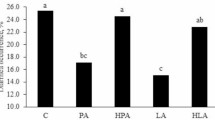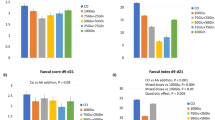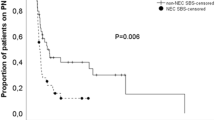Abstract
Background:
Short-bowel syndrome (SBS) is the most common cause of neonatal intestinal failure. Recovery requires intestinal adaptation, dependent on enteral nutrition (EN) and growth factors such as glucagon-like peptide–2 (GLP-2), which is secreted from L cells in the ileum. Neonatal SBS often results in loss of ileum; therefore, we hypothesized that without ileum, endogenous GLP-2 production would be inadequate to promote adaptation. We compared endogenous GLP-2 production and adaptation in neonatal animals with SBS, with and without ileum.
Methods:
Neonatal piglets (4–6 d) were randomized to 75% mid-intestinal resection, 75% distal-intestinal resection, or sham control without resection. Postoperatively, all piglets commenced parenteral nutrition (PN), tapering as EN was increased to maintain specific growth.
Results:
The resected SBS piglets developed intestinal failure, requiring a longer duration of PN support and experiencing fat malabsorption. The piglets without ileum were not able to wean from PN during the study and did not show adaptation, specifically growth in intestinal length or crypt hyperplasia on histology of the jejunum. Adaptation was observed in the resected SBS piglets with ileum, and these piglets also had an increased plasma GLP-2 level that was not observed in piglets without ileum.
Conclusion:
SBS piglets with ileum undergo adaptation associated with increased endogenous GLP-2 production. SBS piglets without ileum undergo limited adaptation and severe intestinal failure, requiring prolonged PN support. This appears to be related to a deficiency in endogenous GLP-2 production.
Similar content being viewed by others
Log in or create a free account to read this content
Gain free access to this article, as well as selected content from this journal and more on nature.com
or
References
Wales PW, de Silva N, Kim J, Lecce L, To T, Moore A . Neonatal short bowel syndrome: population-based estimates of incidence and mortality rates. J Pediatr Surg 2004;39:690–5.
Chaet MS, Farrell MK, Ziegler MM, Warner BW . Intensive nutritional support and remedial surgical intervention for extreme short bowel syndrome. J Pediatr Gastroenterol Nutr 1994;19:295–8.
Grosfeld JL, Rescorla FJ, West KW . Short bowel syndrome in infancy and childhood. Analysis of survival in 60 patients. Am J Surg 1986;151:41–6.
Cole CR, Hansen NI, Higgins RD, Ziegler TR, Stoll BJ ; Eunice Kennedy Shriver NICHD Neonatal Research Network. Very low birth weight preterm infants with surgical short bowel syndrome: incidence, morbidity and mortality, and growth outcomes at 18 to 22 months. Pediatrics 2008;122:e573–82.
Dowling RH, Booth CC . Structural and functional changes following small intestinal resection in the rat. Clin Sci 1967;32:139–49.
Cisler JJ, Buchman AL . Intestinal adaptation in short bowel syndrome. J Investig Med 2005;53:402–13.
Ørskov C, Hartmann B, Poulsen SS, Thulesen J, Hare KJ, Holst JJ . GLP-2 stimulates colonic growth via KGF, released by subepithelial myofibroblasts with GLP-2 receptors. Regul Pept 2005;124:105–12.
Sigalet DL, Bawazir O, Martin GR, et al. Glucagon-like peptide-2 induces a specific pattern of adaptation in remnant jejunum. Dig Dis Sci 2006;51:1557–66.
Martin GR, Wallace LE, Hartmann B, et al. Nutrient-stimulated GLP-2 release and crypt cell proliferation in experimental short bowel syndrome. Am J Physiol Gastrointest Liver Physiol 2005;288:G431–8.
Drucker DJ . Biological actions and therapeutic potential of the glucagon-like peptides. Gastroenterology 2002;122:531–44.
Scott RB, Kirk D, MacNaughton WK, Meddings JB . GLP-2 augments the adaptive response to massive intestinal resection in rat. Am J Physiol 1998;275(5 Pt 1):G911–21.
Brubaker PL, Izzo A, Hill M, Drucker DJ . Intestinal function in mice with small bowel growth induced by glucagon-like peptide-2. Am J Physiol 1997;272(6 Pt 1):E1050–8.
Drucker DJ, Erlich P, Asa SL, Brubaker PL . Induction of intestinal epithelial proliferation by glucagon-like peptide 2. Proc Natl Acad Sci USA 1996;93:7911–6.
Roberge JN, Brubaker PL . Secretion of proglucagon-derived peptides in response to intestinal luminal nutrients. Endocrinology 1991;128:3169–74.
Bozkurt A, Näslund E, Holst JJ, Hellström PM . GLP-1 and GLP-2 act in concert to inhibit fasted, but not fed, small bowel motility in the rat. Regul Pept 2002;107:129–35.
Ljungmann K, Hartmann B, Kissmeyer-Nielsen P, Flyvbjerg A, Holst JJ, Laurberg S . Time-dependent intestinal adaptation and GLP-2 alterations after small bowel resection in rats. Am J Physiol Gastrointest Liver Physiol 2001;281:G779–85.
Kaji T, Tanaka H, Redstone H, Wallace LE, Holst JJ, Sigalet DL . Temporal changes in the intestinal growth promoting effects of glucagon-like peptide 2 following intestinal resection. J Surg Res 2009;152:271–80.
Sibbons PD, Spitz L, van Velzen D . Collateral blood flow in the distal ileum of neonatal piglets: a clue to the pathogenesis of necrotizing enterocolitis. Pediatr Pathol 1992;12:15–27.
Turner JM, Wales PW, Nation PN, et al. Novel neonatal piglet models of surgical short bowel syndrome with intestinal failure. J Pediatr Gastroenterol Nutr 2011;52:9–16.
Book SA, Bustad LK . The fetal and neonatal pig in biomedical research. J Anim Sci 1974;38:997–1002.
Moughan PJ, Rowan AM . The pig as a model animal for human-nutrition research. Proc Nutr Soc NZ 1989;14:116–23.
Larsson LI, Holst J, Håkanson R, Sundler F . Distribution and properties of glucagon immunoreactivity in the digestive tract of various mammals: an immunohistochemical and immunochemical study. Histochemistry 1975;44:281–90.
Sigalet DL, Martin G, Meddings J, Hartman B, Holst JJ . GLP-2 levels in infants with intestinal dysfunction. Pediatr Res 2004;56:371–6.
Diamond IR, Struijs MC, de Silva NT, Wales PW . Does the colon play a role in intestinal adaptation in infants with short bowel syndrome? A multiple variable analysis. J Pediatr Surg 2010;45:975–9.
Nian M, Gu J, Irwin DM, Drucker DJ . Human glucagon gene promoter sequences regulating tissue-specific versus nutrient-regulated gene expression. Am J Physiol Regul Integr Comp Physiol 2002;282:R173–83.
Fuller PJ, Beveridge DJ, Taylor RG . Ileal proglucagon gene expression in the rat: characterization in intestinal adaptation using in situ hybridization. Gastroenterology 1993;104:459–66.
Jeppesen PB, Hartmann B, Hansen BS, Thulesen J, Holst JJ, Mortensen PB . Impaired meal stimulated glucagon-like peptide 2 response in ileal resected short bowel patients with intestinal failure. Gut 1999;45:559–63.
Burrin DG, Stoll B, Jiang R, et al. Minimal enteral nutrient requirements for intestinal growth in neonatal piglets: how much is enough? Am J Clin Nutr 2000;71:1603–10.
Xiao Q, Boushey RP, Drucker DJ, Brubaker PL . Secretion of the intestinotropic hormone glucagon-like peptide 2 is differentially regulated by nutrients in humans. Gastroenterology 1999;117:99–105.
Burrin D, Guan X, Stoll B, Petersen YM, Sangild PT . Glucagon-like peptide 2: a key link between nutrition and intestinal adaptation in neonates? J Nutr 2003;133:3712–6.
Nelson DW, Murali SG, Liu X, Koopmann MC, Holst JJ, Ney DM . Insulin-like growth factor I and glucagon-like peptide-2 responses to fasting followed by controlled or ad libitum refeeding in rats. Am J Physiol Regul Integr Comp Physiol 2008;294:R1175–84.
Holst JJ, Christiansen J, Kühl C . The enteroglucagon response to intrajejunal infusion of glucose, triglycerides, and sodium chloride, and its relation to jejunal inhibition of gastric acid secretion in man. Scand J Gastroenterol 1976;11:297–304.
Jeppesen PB, Hartmann B, Thulesen J, et al. Glucagon-like peptide 2 improves nutrient absorption and nutritional status in short-bowel patients with no colon. Gastroenterology 2001;120:806–15.
Wykes LJ, Ball RO, Pencharz PB . Development and validation of a total parenteral nutrition model in the neonatal piglet. J Nutr 1993;123:1248–59.
AOAC International. Official Methods of Analysis of AOAC International. Arlington, VA: Association of Analytical Chemists, 2000.
Hartmann B, Johnsen AH, Orskov C, Adelhorst K, Thim L, Holst JJ . Structure, measurement, and secretion of human glucagon-like peptide-2. Peptides 2000;21:73–80.
Orskov C, Holst JJ, Knuhtsen S, Baldissera FG, Poulsen SS, Nielsen OV . Glucagon-like peptides GLP-1 and GLP-2, predicted products of the glucagon gene, are secreted separately from pig small intestine but not pancreas. Endocrinology 1986;119:1467–75.
Petersen YM, Burrin DG, Sangild PT . GLP-2 has differential effects on small intestine growth and function in fetal and neonatal pigs. Am J Physiol Regul Integr Comp Physiol 2001;281:R1986–93.
Acknowledgements
The authors acknowledge the assistance of Rhian Ormond, Christine Pendlebury, Charlane Gorsak, and all the staff of the Swine Research and Technology Center.
Author information
Authors and Affiliations
Corresponding author
Rights and permissions
About this article
Cite this article
Hua, Z., Turner, J., Sigalet, D. et al. Role of glucagon-like peptide–2 deficiency in neonatal short-bowel syndrome using neonatal piglets. Pediatr Res 73, 742–749 (2013). https://doi.org/10.1038/pr.2013.44
Received:
Accepted:
Published:
Issue date:
DOI: https://doi.org/10.1038/pr.2013.44
This article is cited by
-
Sleeve Gastrectomy Does Not Cause Hypertrophy and Reprogramming of Intestinal Glucose Metabolism in Rats
Obesity Surgery (2015)
-
Exogenous glucagon-like peptide-2 improves outcomes of intestinal adaptation in a distal-intestinal resection neonatal piglet model of short bowel syndrome
Pediatric Research (2014)



